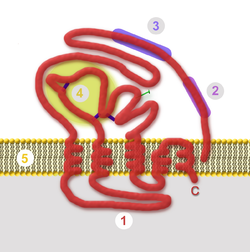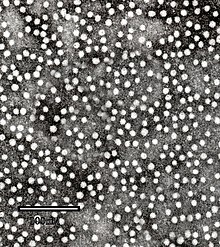HBsAg
| HBsAg | ||
|---|---|---|

|
||
| Schematic structure of HBsAg with intracellular domain (1), T-cell epitope (2), docking point (3), hypervariable domain (4) and lipid bilayer (5) | ||
| other names |
|
|
| Mass / length primary structure | 226 amino acids , 25.4 kDa | |
| Identifier | ||
| External IDs | ||
HBsAg ( English HBV surface antigen , HBV surface antigen ) is a surface protein in the viral envelope of the hepatitis B virus (HBV). The HBsAg is also the active ingredient in the approved hepatitis B vaccines .
properties
HBsAG is a transmembrane protein with five membrane passages and three disulfide bridges on the outside of the membrane. At the same time, it is an antigen against which neutralizing antibodies are formed during infection or after vaccination . It serves as a receptor for HBV to dock on to glycosaminoglycans and then to bind to NTCP (Na + -taurocholate cotransporting polypeptide) on a host cell. HBsAg then serves as a fusogenic protein to release HBV into the cytosol . HBsAg was originally called the Australia antigen by Baruch Blumberg , as it was found in the blood of an Australian Aboriginal . HBsAg spontaneously forms virosomes with a diameter of 20 nm, which in infected people reach a concentration of up to 10 12 particles per milliliter of blood.
The appearance of anti-HBs - antibodies ( seroconversion ) to HBsAg marks the transition to non-infectious disease. Furthermore, in the course of the virological diagnosis, an infection with HBV is detected by determining the serum HBsAg or by antigen ELISA . In histotechnology , HBsAg can be stained by Shikata orcein staining. Antibodies against it can be detected about fourteen days after vaccination with HBsAg.
One of the first vaccines against HBV ( Heptavax ) was purified from the blood plasma of those infected with HBV ; due to the risk of contamination by other pathogens , it was later switched to recombinant HBsAg from baker's yeast .
The hepatitis D virus needs HBsAg to become pathogenic.
Individual evidence
- ↑ Baruch S. Blumberg: A "New" Antigen in Leukemia Sera. In: JAMA 191, 1965, p. 541, doi : 10.1001 / jama.1965.03080070025007 .
- ↑ DM Knipe, Peter M. Howley (Ed.): Fields Virology . 5th edition, Philadelphia 2007. ISBN 0-7817-6060-7 .
- ↑ P. Guarascio, F. Yentis, U. Cevikbas, B. Portmann, R. Williams: Value of copper-associated protein in diagnostic assessment of liver biopsy .. In: Journal of Clinical Pathology . 36, 1983, p. 18, doi : 10.1136 / jcp.36.1.18 .
- ↑ Carolyn D Rysgaard, Cory S Morris, Denny Drees, Tami Bebber, Scott R Davis, Jeff Kulhavy, Matthew D Krasowski: Positive hepatitis B surface antigen tests due to recent vaccination: a persistent problem. In: BMC Clinical Pathology. 12, 2012, p. 15, doi : 10.1186 / 1472-6890-12-15 .
- ↑ N. Chai, HE Chang, E. Nicolas, Z. Han, M. Jarnik, J. Taylor: Properties of subviral particles of hepatitis B virus. In: Journal of virology. Volume 82, Number 16, August 2008, ISSN 1098-5514 , pp. 7812-7817, doi : 10.1128 / JVI.00561-08 . PMID 18524834 , PMC 2519590 (free full text).
